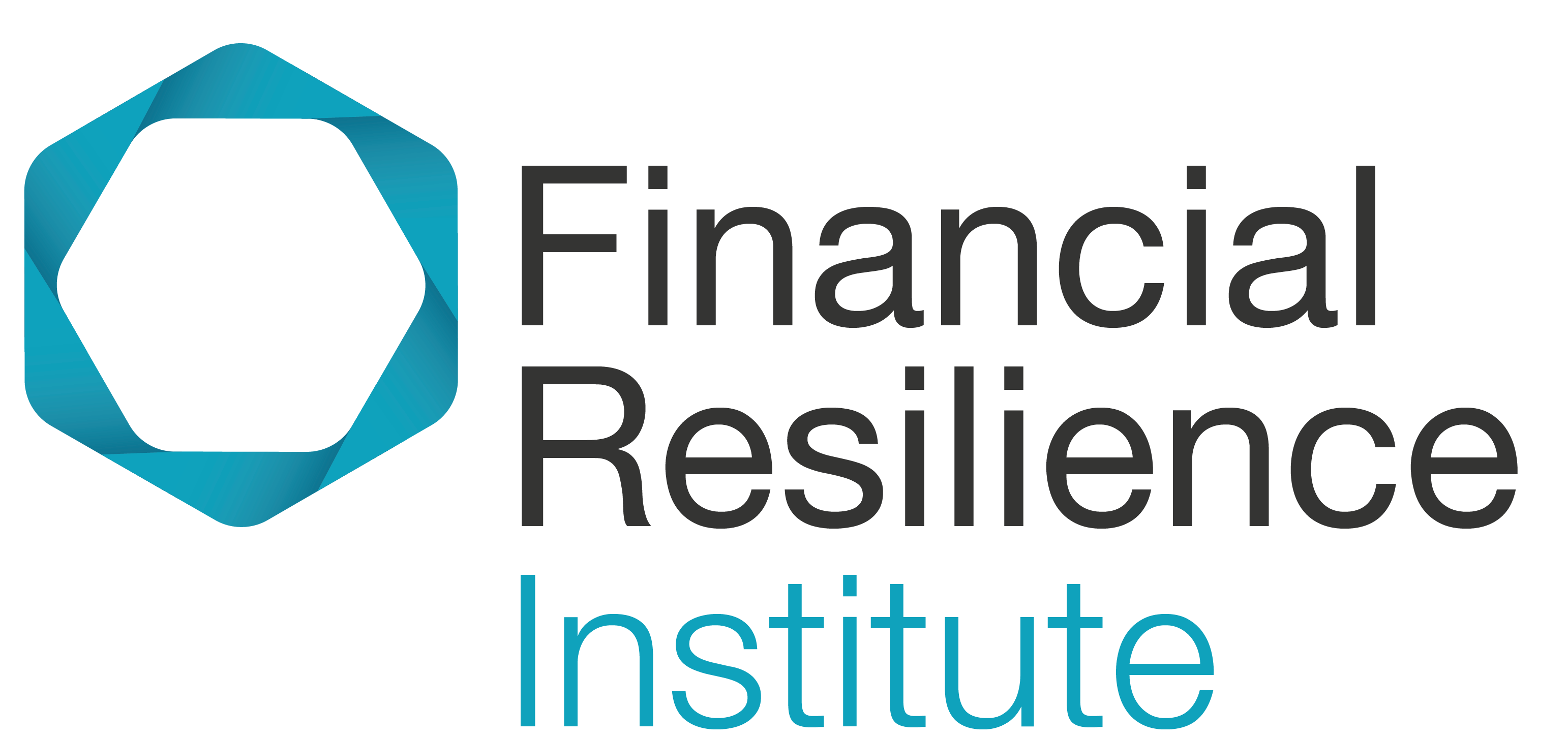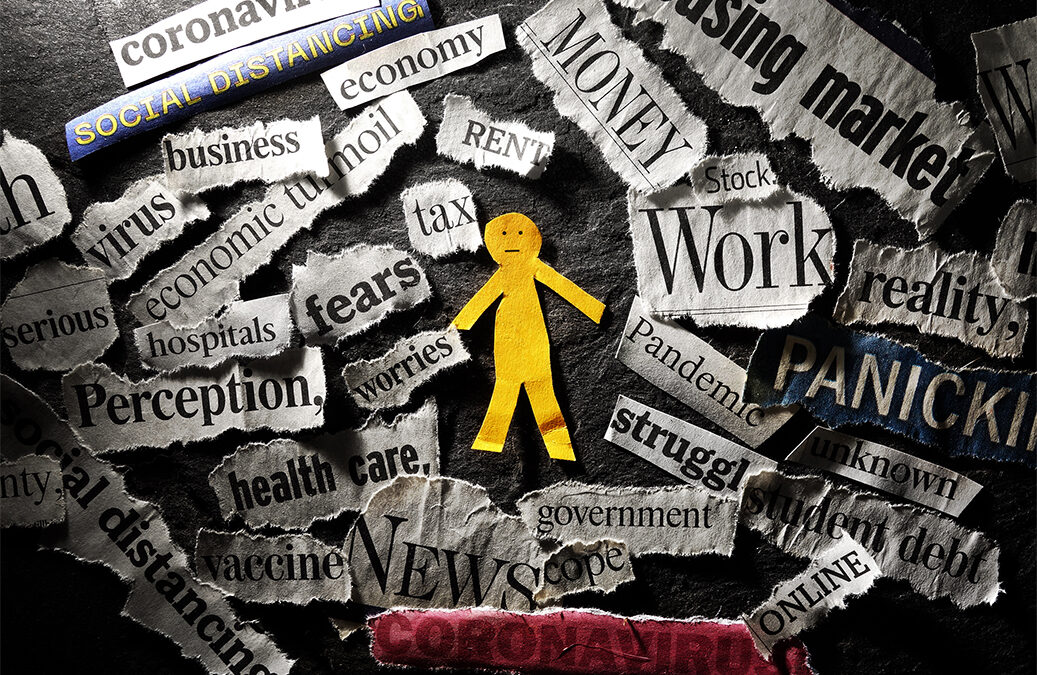Source: The American Psychological Association | Date: May 19, 2022
March 11, 2022, marks the second anniversary of the COVID-19 global pandemic declaration by the World Health Organization. In the two years since that declaration, virtually all aspects of life have been altered.
To better understand the impact of the past two years on individual stress, the American Psychological Association partnered with The Harris Poll to conduct a survey between February 7 and 14, 2022. In light of recent events leading up to its release, the survey was supplemented by a late-breaking poll, fielded March 1-3.
These more recent findings were alarming, with more adults rating inflation and issues related to the invasion of Ukraine as stressors than any other issue asked about since the Stress in AmericaTM survey began in 2007. Top sources of stress were the rise in prices of everyday items due to inflation (e.g., gas prices, energy bills, grocery costs, etc.) (87%), followed by supply chain issues (81%) and global uncertainty (81%).
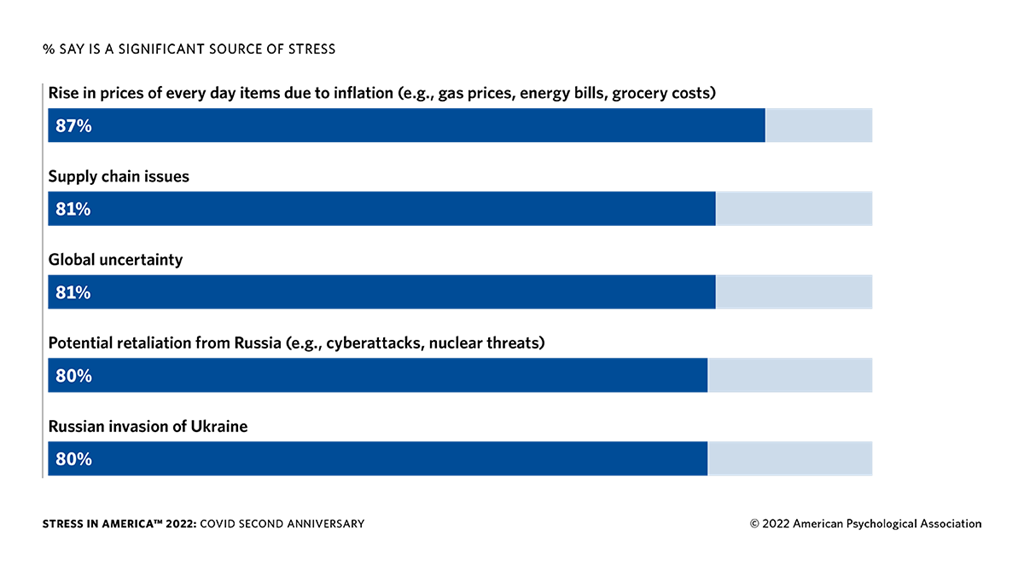
These serious stressors are coming at a time when the nation is still struggling to deal with the strain of the prolonged pandemic. Close to two-thirds of adults (63%) said their life has been forever changed by the COVID-19 pandemic, according to the new survey. In addition, the survey revealed widespread grief and sense of loss, continued hardships for vulnerable populations, concerns for children’s development among parents, and entrenched, unhealthy coping habits. Money stress registered at the highest recorded level since 2015, revealed the broader poll.
As individuals live in this unpredictable state of prolonged hypervigilance and growing financial strain, this new geopolitical threat has emerged—one that America’s youngest generations have never experienced. Russia’s invasion of Ukraine has brought new concerns about potentially unbearable economic consequences and threats of nuclear war.
War in Ukraine spurs mass fear and anxiety as U.S. adults watch in horror
In the March poll, the vast majority of adults reported global uncertainty (81%), the Russian invasion of Ukraine (80%) and potential retaliation from Russia (e.g., cyberattacks or nuclear threats) (80%) to be significant sources of stress. Eighty-four percent of U.S. adults agreed the Russian invasion of Ukraine has been terrifying to watch. Moreover, 69% of adults reported they are worried the invasion of Ukraine is going to lead to nuclear war, and that they fear that we are at the beginning stages of World War III.
The survey findings make clear that U.S. adults appear to be emotionally overwhelmed and showing signs of fatigue. The vast majority of adults (87%) agreed it feels like there has been a constant stream of crises over the last two years, and more than seven in 10 (73%) said they are overwhelmed by the number of crises facing the world right now.
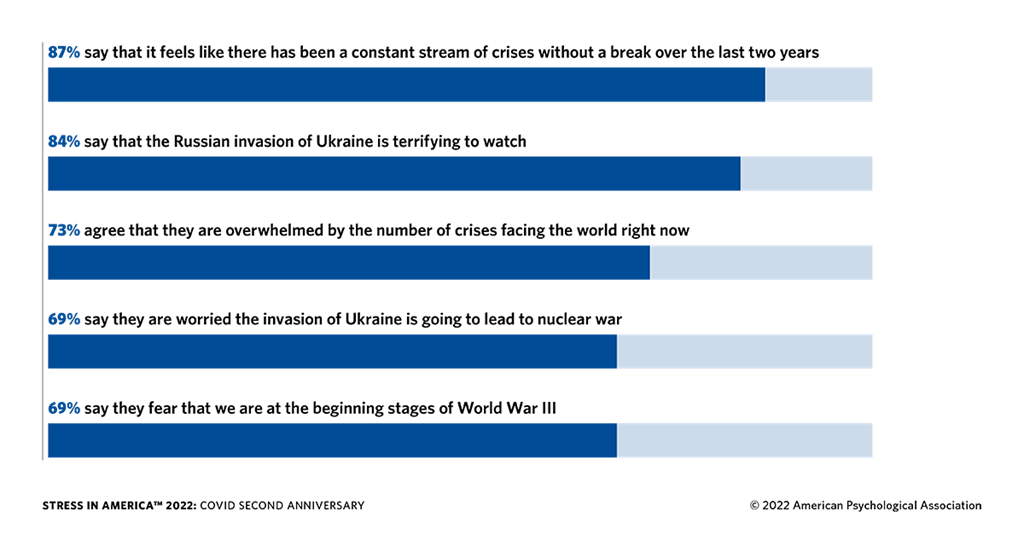
Amid historic inflation spike and geopolitical strife, money and economic stress is mounting
Russia’s invasion of Ukraine and the unpredictability of the extent to which the conflict may intensify is compounding existing financial stressors that were already on the rise. Soon after Russia began bombing Ukraine, world stock markets wavered. Further, economists predict a surge in energy, wheat, corn, steel, and iron prices.
Americans are bracing for economic hardship. The March survey found the rise in prices of everyday items due to inflation was rated as a stressor by the highest proportion of adults seen across all stressors asked about in the history of the Stress in America™ survey, with 87% having reported it as a significant source of stress. Not far behind was stress related to supply chain issues (81%).
The broader survey fielded in February showed the proportion of adults who noted money as a source of stress (65%) was up significantly from the Stress in America surveys in June (61%)1 and February (57%)2 2021. Similarly, the number of adults who noted the economy as a significant source of stress (65%) has risen significantly from the Stress in America surveys in August (59%)3 and June (58%)4. Half of all U.S. adults (50%) indicated housing costs as a significant stressor, which is up from February 2021 (46%)5.
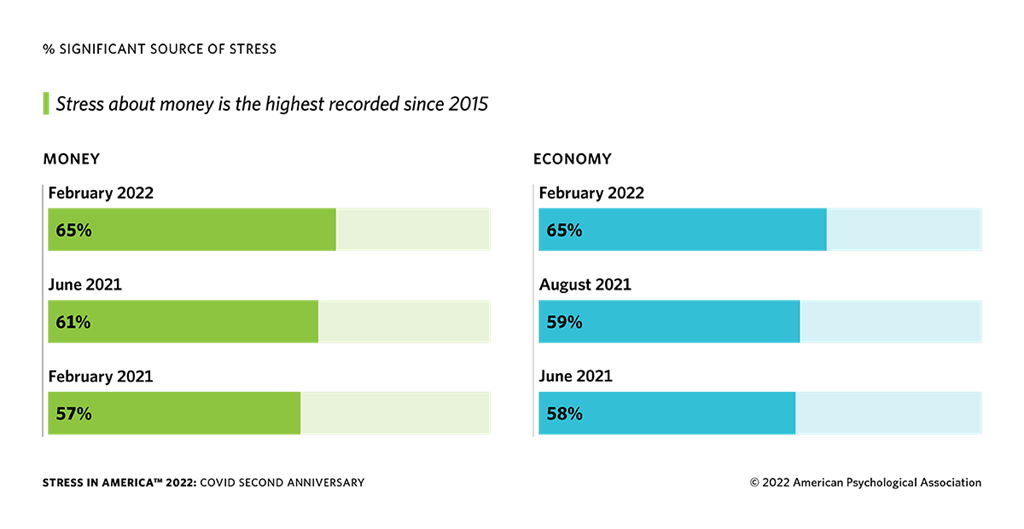
Younger adults ages 18 to 43 were more likely than those ages 44+ to report money as a significant source of stress (82% ages 18 to 25 and 81% ages 26 to 43 vs. 68% ages 44 to 57, 43% ages 58 to 76, and 21% ages 77+). Adults ages 26 to 43 were more likely than every other age group to say both housing costs (68% vs. 10% to 58%) and the economy (76% vs. 54% to 66%) are significant sources of stress.
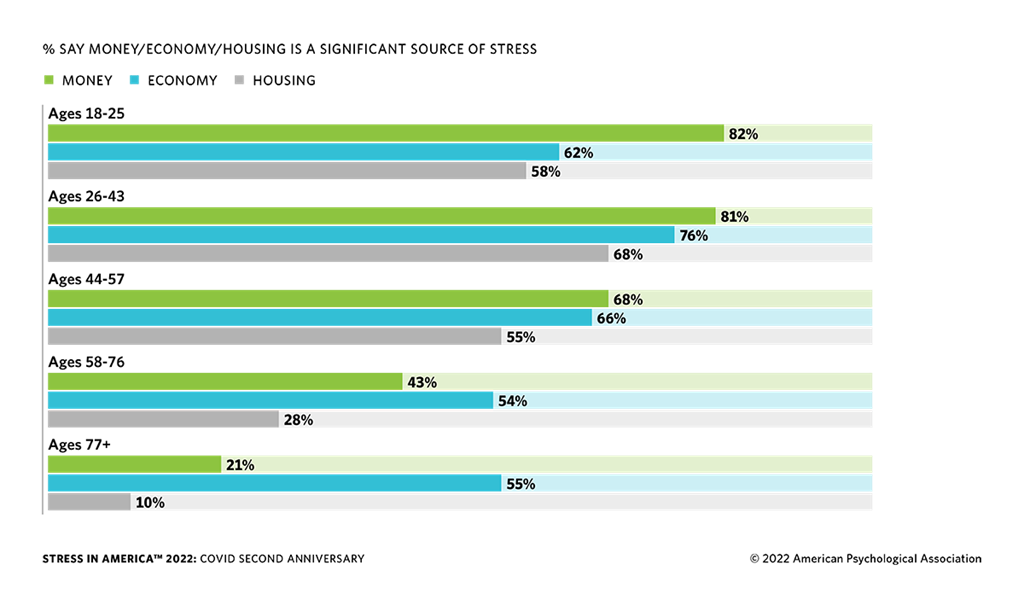
Latino (75%) and Black adults (67%) noted money to be a significant stressor more frequently than White (63%) and Asian (57%) adults. Similarly, Latino adults were more likely than other racial/ethnic groups to say the economy is a significant source of stress (73% vs. 65% Black, 63% White, and 60% Asian). Finally, Latino (62%) and Black (57%) adults were more likely than their Asian (47%) and White (45%) counterparts to report housing costs to be a significant source of stress.
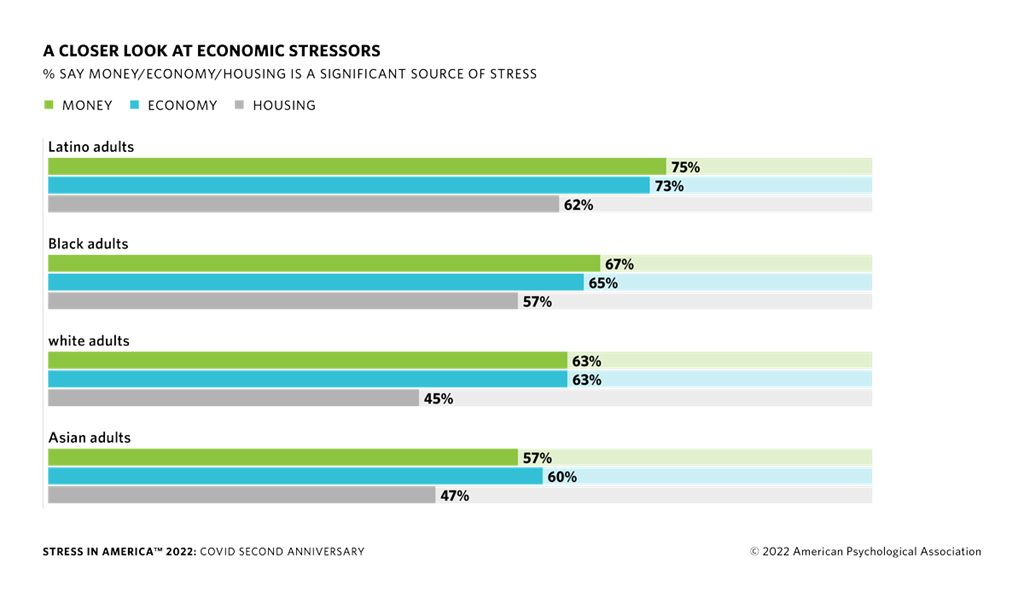
Parents6 were more likely than those who are not parents to list money (80% vs. 58%), the economy (77% vs. 59%), and housing costs (72% vs. 39%) as significant sources of stress. Democrats were more likely than Republicans and independents to note both money (72% vs. 57% Republicans, 59% independents) and housing costs (55% vs. 41% Republicans, 43% independents) as significant stressors.
Those who reside in urban areas were more likely than their suburban counterparts to experience significant stress surrounding money (70% urban vs. 63% suburban), the economy (68% vs. 61%), and housing costs (58% vs. 45%).
1APA Racial Trauma Survey, June 2021
2APA 2021 Pandemic Anniversary Survey, February 2021
3APA COVID Resilience Survey, August 2021
4APA Racial Trauma Survey, June 2021
5APA 2021 Pandemic Anniversary Survey, February 2021
6Parents are defined as U.S. adults ages 18+ who have at least one person under the age of 18 living in their household at least 50% of the time for whom they are the parent or guardian.
Sustained survival mode gives way to entrenched unhealthy behavior and health consequences
While close to two-thirds of adults (63%) said their life has been forever changed by the COVID-19 pandemic, this varies by racial/ethnic group. Specifically, Latino (67%) and Asian (69%) adults were more likely than White adults (51%) to agree their life has been forever changed by the pandemic.
A year ago, Stress in America™ One Year Later, A New Wave of Pandemic Health Concerns, APA’s first pandemic anniversary survey, found COVID-19-related stress was associated with unhealthy weight gains and increased drinking. These unhealthy behaviors have persisted through the second year of the pandemic, suggesting that coping mechanisms have become entrenched—and mental and physical health is on a continuing decline for many as a result.
Most Americans have experienced changes in their health and habits since the beginning of the pandemic. Many reported worse mental health, lower physical activity, disturbed sleep, and increased reliance on unhealthy habits. Just over half of U.S. adults (51%) disagreed that overall, their life has gotten healthier over the course of the COVID-19 pandemic, and two in five (42%) said that they have relied on a lot of unhealthy habits to get themselves through the last two years.
Further underlining a decline in physical health, close to half of adults (47%) said they have been less active than they wanted to be since the pandemic started, and close to three in five (58%, in line with 61% this time last year) reported experiencing undesired weight changes.
Groups more likely to indicate undesired weight changes included younger adults (70% ages 18 to 25, 68% ages 26 to 43, and 61% ages 44 to 57 vs. 46% ages 58 to 76 and 24% ages 77%+), parents (69% vs. 53% of those who are not parents), Latino and Black adults (63% and 64% vs. 57% White adults) and essential workers (68% vs. 55% of those who are not essential workers).
Among those who gained more weight than they wanted, the average amount of weight gained was 26 pounds, with a median of 15 pounds. On the other hand, the average amount of weight lost among those who lost more than they wanted to was 27 pounds, with a median of 15 pounds.
More than one in five Americans (23%) said they have been drinking more alcohol during the COVID-19 pandemic to cope with their stress. Adults who said they have been drinking more alcohol to cope with stress reported consuming an average of 10 drinks per week (and a median of six drinks per week), compared with an average of two drinks (and a median of one drink) per week among those who did not report drinking more.
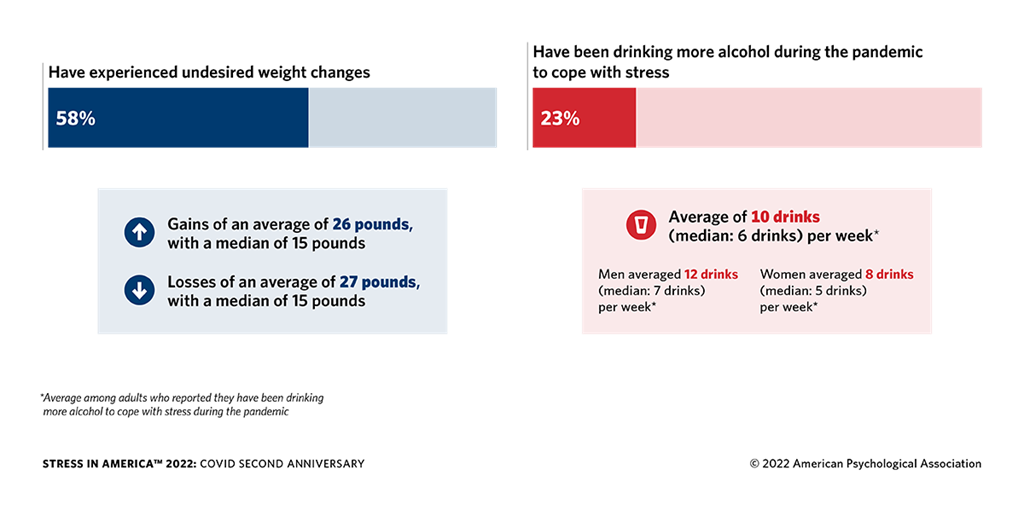
Men were more likely to say they have been drinking more alcohol during the pandemic to cope with stress (25% vs. 20% of women), and of those who did report more consumption, males averaged 12 drinks (median: seven drinks) per week, compared with an eight-drink average (median: five drinks) reported by women who said they were drinking more to cope with stress.
Ongoing coexistence with pandemic stressors suggests adults are enduring but not recovering. Grief, sense of loss remain
U.S. adults have faced devastating impacts as a result of COVID-19 pandemic, yet stress seems to have leveled, as fear of illness from the disease itself is no longer top of mind; the majority of consumers are less scared of getting COVID-19 than they were at the beginning of the pandemic.
Though the majority of U.S. adults (72%) agreed that they are not as scared about getting COVID-19 as they were in the beginning of the pandemic, close to three in five (58%) agreed the pandemic overall is a daily stressor. Latino (63%) and Asian (64%) adults were more likely than their White counterparts (55%) to say the COVID-19 pandemic is a daily stressor. Parents (70% vs. 52% non-parents) and adults ages 18 to 57 (61% ages 18 to 25, 68% ages 26 to 43, and 58% ages 44 to 57 vs. 47% ages 58 to 76 and 39% ages 77+) also reported higher agreement that the pandemic is a daily stressor.
Further, U.S. adults are grieving the experiences and time they can’t get back. While many said having plans gives them something to look forward to, they also feel it is impossible make plans because of the unpredictability of the pandemic. Three in five U.S. adults (61%) said there have been events that they haven’t been able to carry out or attend in the past two years as a result of the COVID-19 pandemic (e.g., trips, vacations, weddings, birthday parties, graduation parties, baby showers, etc.). Latino adults (70%) were more likely to report missing out on events the past two years than White (61%) and Black (56%) adults.
Emotional impacts of the restrictions and lockdowns are clear—close to two-thirds said it makes them sad to think about the things they have missed out on because of the COVID-19 pandemic (64%) and that they feel the COVID-19 pandemic has stolen major life moments they will never get back (64%).
Younger adults ages 18 to 43 were more likely than those ages 58+ to say the COVID-19 pandemic has stolen major life moments they will never get back (77% ages 18 to 25 and 70% ages 26 to 43 vs. 50% ages 58 to 76 and 51% ages 77+) and to agree that it made them sad to think about the things they have missed out on because of the pandemic (74% ages 18 to 25 and 72% ages 26 to 43 vs. 52% ages 58 to 76 and 54% ages 77+). Asian adults were more likely to agree that the pandemic has stolen major life moments they will never get back (74% vs. 66% Black, 65% Latino, and 59% White).
U.S. adults reported separation and conflict as causes for straining and/or ending of relationships. Half of Americans (51%, particularly essential workers at 61%) said they have loved ones they have not been able to see in person in the past two years as a result of the COVID-19 pandemic. To this point, the majority of Americans (69%) agreed that they have gone longer without seeing close family or friends than they ever have in their life due to the COVID-19 pandemic.
Strikingly, more than half of all U.S. adults (58%) reported experiencing a relationship strain or end as a result of the following conflicts related to the COVID-19 pandemic:
- Canceling events or gatherings due to COVID-19 concerns (29%)
- Difference of opinion over some aspect of vaccines (e.g., their efficacy, whether or not to get them, etc.) (25%)
- Different views of the pandemic overall (25%)
- Difference of opinion over mask-wearing (24%)
- Differences in opinion of the health risks of getting COVID-19 (22%)
- Difference of opinion over what to do when exposed to COVID-19 (17%)
Whether they experienced relationship impacts or not, nearly half of Americans (47%) agreed that they have felt very lonely during the COVID-19 pandemic. Still, the slower pace of life may have attributed to two in five (40%) agreeing that they have connected or formed relationships with people they would not have if it weren’t for the COVID-19 pandemic.
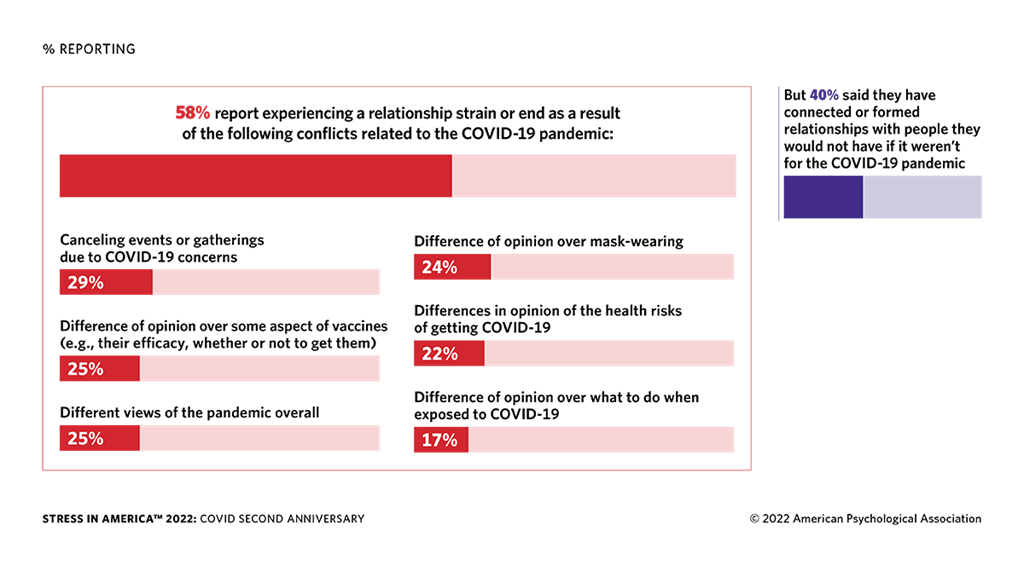
Optimism is waning as the majority of U.S. adults (66%) agreed that with each new variant, they lose hope that the COVID-19 pandemic will ever end. A quarter of adults (24%) strongly agreed with this statement. Similar proportions (69%) agreed that, at one point, they thought the pandemic was nearly over. Further, while the vast majority of Americans (85%) agreed that having plans gives them something to look forward to, nearly two-thirds (65%) said that the ever-changing nature of the COVID-19 pandemic makes it impossible to plan anything.
The nation’s confidence and sense of time seem to have diminished as well, as most agreed that the past two years of the COVID-19 pandemic are a blur (63%). Asian adults (71% vs. 62% Latino, 62% White, and 61% Black) and parents (72% vs. 59% non-parents) were more likely to feel the past two years of the pandemic are a blur.
On the positive side, seven in 10 Americans (71%) said they have gotten better at prioritizing what is important to them because of the COVID-19 pandemic, and more than half (53%) have enjoyed having fewer plans than they did before the COVID-19 pandemic.
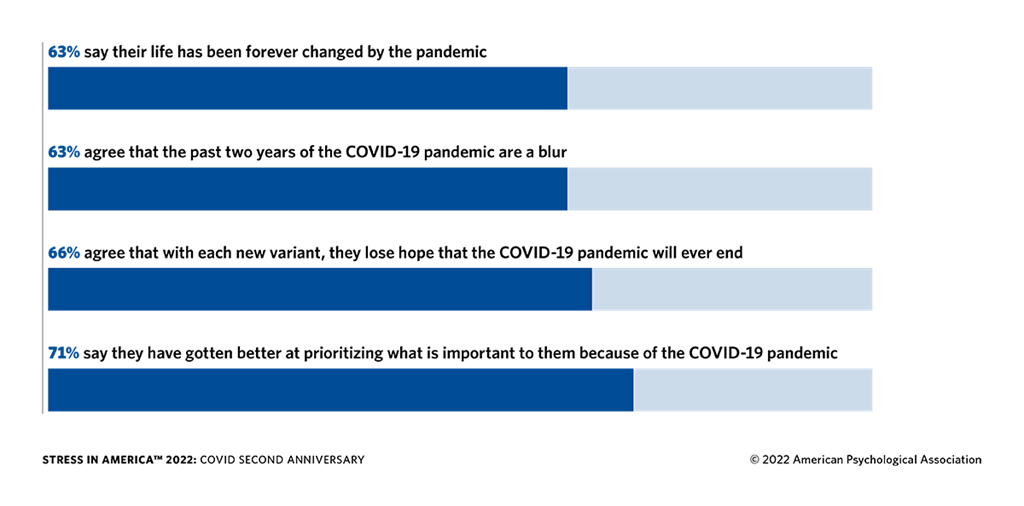
Some populations still reporting higher levels of prolonged stress and lack of support
Over the past two years, younger generations, Latino adults, and parents have consistently reported more stress than others. U.S. adults overall reported an average current stress level related to the COVID-19 pandemic of 5.0 on a scale of 1 to 10 where 1 means you have “little or no stress” and 10 means you have “a great deal of stress.” Younger generations reported higher average stress levels around the pandemic than adults ages 58 or older (5.8 for ages 18 to 25, 5.5 for ages 26 to 43, and 5.2 for ages 44 to 57 vs. 4.2 for ages 58 to 76 and 3.7 for ages 77+); Latino adults reported an average stress level related to the pandemic of 5.5, which is higher than the average current stress levels reported by White adults (4.9); and parents reported a higher average current stress level related to the pandemic (5.6 vs. 4.7) than those who are not parents.
Additional populations that reported higher average current stress levels due to the pandemic include employed adults (5.3 vs. 4.6 non-employed), Democrats (5.4 vs. 4.7 Republicans and 4.8 independents) and those who could have used more emotional support over the pandemic (6.1 vs. 3.6).
Overall, 41% of U.S. adults say the level of stress in their lives has increased compared with before the COVID-19 pandemic. Those who reported that they could have used more emotional support over the pandemic were twice as likely than those who do not feel they could have used more support to say the level of stress in their lives has increased (52% vs. 27%).
Reasons for increased stress among those who could have used more emotional support over the pandemic include:
- “Prices are higher and that makes my life harder” – Female, 60
- “Loss of income (job)” – Male, 33
- “The pandemic not being over” – Female, 44
- “Worry for family” – Male, 20
Parents fear that children are losing developmentally. Long- and short-term impacts seem inevitable
Parents are encumbered by concerns of long- and short-term impacts of disruptions to child development. Parents overwhelmingly reported concerns regarding child(ren)’s development, including social life or development (73%), academic development (71%) and emotional health or development (71%). More than two-thirds of parents reported concern about the pandemic’s impact on their child’s cognitive development (68%) and their physical health/development (68%).
Parents also said that disruptions to and uncertainty surrounding school and/or daycare were contributing to their stress, but perhaps more significantly have possible implications for children’s development. Parents reported strong agreement that:
- Disruption to their child’s schedule due to the COVID-19 pandemic is stressful for them (72%).
- It feels like the rules around COVID-19 testing change constantly for their child(ren)’s school/daycare (69%).
- Trying to keep up with the rules and regulations for COVID-19 for their child/children’s school and activities is difficult (68%).
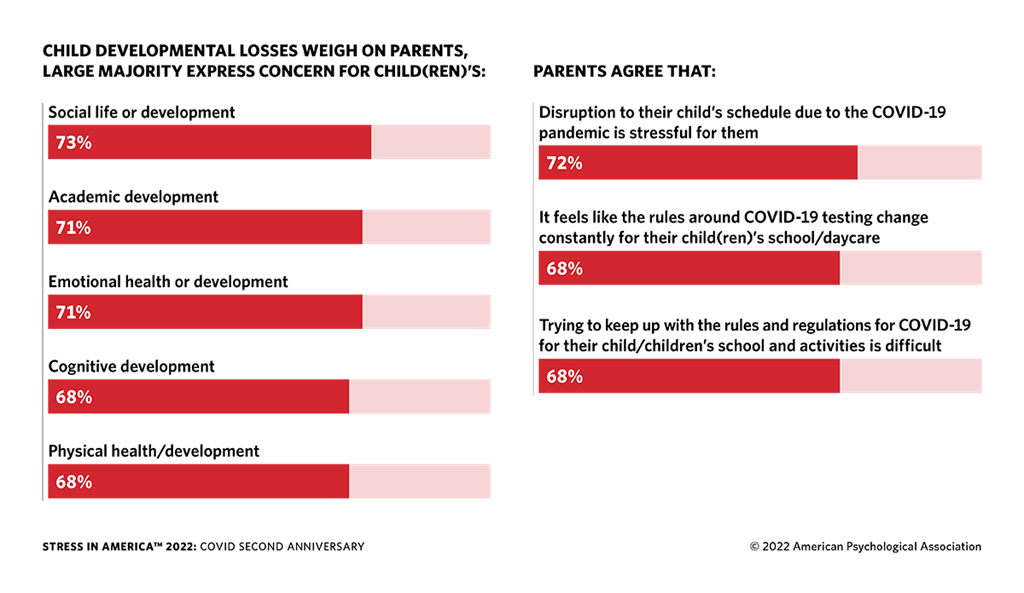
Further, more than half of parents (57%) said they feel like their children could have benefited from receiving treatment from a mental health professional since the pandemic started—particularly parents of teens ages 13 to 17 (65%). These concerns of parents are backed by research demonstrating the pandemic’s impact on youth mental health, including among children who did not previously exhibit symptoms of a behavioral health disorder.7
The mental health of children is frequently tied to the overall health, safety and stability of their surroundings. Ongoing national surveys of households with young children have found high levels of childhood hunger, emotional distress among parents, and frequent disruptions in child-care services.8 Recent data show that nearly 10% of U.S. children lived with someone who was mentally ill or severely depressed.9 Furthermore, since the start of the pandemic, over 167,000 children have lost a parent or caregiver to the virus.10 This kind of profound loss can have significant impacts on the mental health of children, leading to anxiety, depression, trauma, and stress-related conditions.
Moreover, increases in demand for pediatric inpatient mental health services are also a particularly concerning indicator. Between April and October 2020, the proportion of children between the ages of 5 and 11 and adolescents ages 12 to 17 visiting an emergency room due to a mental health crisis increased by 24% and 31%, respectively.11 During the first three-quarters of 2021, children’s hospitals reported a 14% increase in mental health related emergencies and a 42% increase in cases of self-injury and suicide, compared with the same period in 2019.12 Faced with such data, in December 2021, the U.S. Surgeon General issued an advisory calling for a unified national response to the mental health challenges young people are facing.13 Considering the rarity of such advisories, this further underscores the need for action to help stem the long-term impacts of the pandemic on the mental health and well-being of children and adolescents.
7Osgood, K., Sheldon-Dean, H., & Kimball, H. (2021). 2021 Children’s Mental Health Report: The Impact of the COVID-19 Pandemic on Children’s Mental Health. Child Mind Institute. Retrieved from: http://wvspa.org/resources/CMHR-2021-FINAL.pdf
8Center for Translational Neuroscience. (2021). RAPID-EC Fact Sheet: Still in Uncertain Times; Still Facing Hunger. University of Oregon. Retrieved from: https://www.uorapidresponse.com/our-research/still-in-uncertain-times-still-facing-hunger; Center for Translational Neuroscience. (2021). RAPID-EC Fact Sheet: Emotional Distress On the Rise for Parents … Again. University of Oregon. Retrieved from: https://www.uorapidresponse.com/emotional-distress-on-rise-again?utm_medium=email&utm_source=email_link&utm_content=baby_monitor_11042021&utm_campaign=Q1_2022_Policy+Center_Resources
9Ullmann, H., Weeks, J. D., Madans, J. H. (2021). Disparities in stressful life events among children aged 5–17 years. National Center for Health Statistics. https://dx.doi.org/10.15620/cdc:109052
10Treglia, D., Cutuli, J. J., Arasteh, K., J. Bridgeland, J.M., Edson, G., Phillips, S., & Balakrishna, A. (2021). Hidden Pain: Children Who Lost a Parent or Caregiver to COVID-19 and What the Nation Can Do to Help Them. COVID Collaborative.
11Leeb, R. T., Bitsko, R. H., Radhakrishnan, L., Martinez, P., Njai, R., Holland, K. M. (2020). Mental Health–Related Emergency Department Visits Among Children Aged <18 Years During the COVID
12Children’s Hospital Association. (2021). COVID-19 and Children’s Mental Health. Retrieved from: https://www.childrenshospitals.org/-
/media/Files/CHA/Main/Issues_and_Advocacy/Key_Issues/MentalHealth/2021/covid_and_childrens_mental_health_factsheet_091721.pdf?la=en&hash=F201013848F9B9C97FAE16A89B01A38547C7C5C7
13Office of the U.S. Surgeon General. (2021). Protecting Youth Mental Health: The U.S. Surgeon General’s Advisory. Retrieved from: https://www.hhs.gov/sites/default/files/surgeon-general-youth-mental-health-advisory.pdf
Many barriers to mental health support make access difficult
With the burdens of missed events, strained relationships and uncertainty about the future, Americans are beginning to see the many benefits of mental health support, yet many struggle to break through barriers to access.
In his first State of the Union address on Tuesday, March 1, President Biden affirmed this challenge facing the nation, urging, “…let’s get all Americans the mental health services they need. More people they can turn to for help, and full parity between physical and mental health care.”
The need for clearer access to mental health services is reflected in survey responses, with more than half of Americans (56%) having said that since the pandemic started, they could have used more emotional support than they received, and 21% could have used a lot more emotional support. Further, parents were more likely to have noted their mental health has worsened over the pandemic (37% vs. 27% of non-parents) and to say they could have used a lot more emotional support over the last two years (31% vs. 16%).
Latino adults (59%) were more likely than their White counterparts (53%) to say they could have used more emotional support than they received since the pandemic started. When looking at age, a desire for more emotional support increases significantly for younger generations (18 to 25: 75% and 26 to 43: 69% vs. 44 to 57: 60%, 58 to 76: 34%, and 77+: 27%).
While just one in five (20%) reported receiving treatment from a mental health professional since the COVID-19 pandemic started, the vast majority of those (80%) agreed they benefited from receiving this treatment. On the other hand, more than a third of adults who did not receive treatment from a mental health professional since the COVID-19 pandemic started (35%) said they feel like they could have benefited from receiving this treatment.
Further, nearly one in five of those who have not received treatment from a mental health professional since the COVID-19 pandemic started (18%) said they are interested in receiving support from a mental health professional. Among this group, around two in five or more noted that access-related issues (including location, timing, and provider capacity) (45%) and costs (including co-pays and insurance coverage) (39%) have prevented them from seeking treatment. More than a quarter (27%) said the thought of reaching out for help is too overwhelming, while around one in five noted that they do not know how to find a mental health professional (21%), they have concerns about privacy (20%), they do not think their problems are serious enough to warrant help (20%), or they have concerns about stigma or other people finding out (18%).
Methodology
The 2022 Pandemic Anniversary Survey was conducted online within the United States by The Harris Poll on behalf of the American Psychological Association between February 7 and 14, 2022, among 3,012 adults age 18+ who reside in the U.S. Interviews were conducted in English and Spanish.
